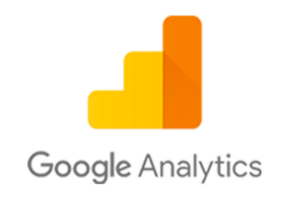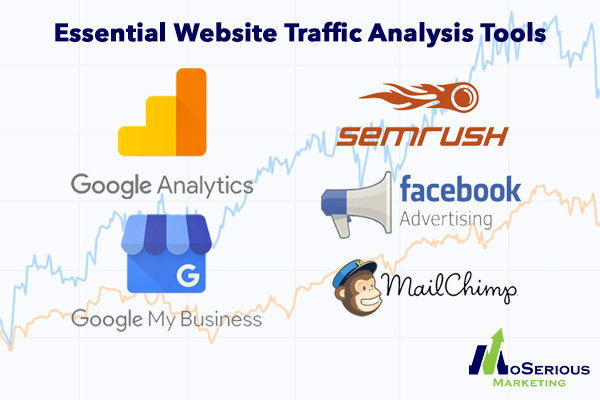I’ve been doing online marketing for almost 20 years. The objective has always been, drive traffic to a website that generates leads. In order to do that effectively, website traffic analysis is imperative. We must understand where the online traffic comes from and and how the user engaged while visiting the website. More importantly…which website visitors actually completed our desired call to actions. Knowledge is power. Knowing how your traffic is engaging, what is causing them to engage, when they choose to engage, and where they engage at, allows you to make powerful marketing adjustments. Was that a run on sentence? For real though, according to LinkedIn, when reviewing reports, “based on their analysis marketers should take immediate action for better results”.
The type of website traffic analysis necessary depends on what online marketing strategies are in place. Most of my clients get a bundle of services that include website design and management, search engine optimization, pay per click management, email marketing, and social media marketing. I use those different mediums to send visitors to the website and generate leads. With lead generation being the overall objective, its important to know which marketing campaigns are working…and which ones aren’t. We meet monthly and discuss performance and leads. Reporting is the foundation that supports the accuracy of the discussion. It confirms if your digital marketing is effective or not. Reports verify which strategies contribute to the bottom line. Reports and confirmation of performance should guide advertising decisions. Numbers don’t lie.
My 5 Favorite Website Traffic Analysis Tools
I use Google Analytics primarily. It’s the best way to analyze website sessions, user behavior, visitor types, and more. Google Analytics gets my attention multiple times a week (for accounts with paid ads). Mailchimp, Facebook Insights, Google My Business Insights, and SEMRush Position Tracking are reviewed monthly and quarterly. My goal is to understand the website traffic. Then I can create goals, and put in place strategies that increase the traffic while converting the traffic to leads.
Google Analytics
 I love Google Analytics, mainly because I’m pro Google (#TeamGmail #TeamAndroid #TeamChrome). It gives me great analysis of the website traffic. For small businesses, understanding the engagement of website visitors is a direct correlation to business growth. Google Analytics is free, robust, and seamlessly syncs with other Google products like Ads, Search Console and Data Studio. One complaint I hear from new clients and others, is that it’s too complicated or it can be overwhelming. If you’re new to it, then it can be. After almost 20 years of using it, I’ve learned which reports work for most small businesses. Although I tend to review Analytics a few times a week, discussing the data with clients works best using calendar months. Which reports you should access depend on the business, industry, website type, and overall internet marketing objective.
I love Google Analytics, mainly because I’m pro Google (#TeamGmail #TeamAndroid #TeamChrome). It gives me great analysis of the website traffic. For small businesses, understanding the engagement of website visitors is a direct correlation to business growth. Google Analytics is free, robust, and seamlessly syncs with other Google products like Ads, Search Console and Data Studio. One complaint I hear from new clients and others, is that it’s too complicated or it can be overwhelming. If you’re new to it, then it can be. After almost 20 years of using it, I’ve learned which reports work for most small businesses. Although I tend to review Analytics a few times a week, discussing the data with clients works best using calendar months. Which reports you should access depend on the business, industry, website type, and overall internet marketing objective.
**I’m starting a new series of post about my favorite Google Analytic reports. The first is about the Channels Report.
Mailchimp Activity
 Mailchimp is my platform of choice when doing email marketing. The activity report shows how many emails were delivered, open rate, clicks from email, and unsubscribes. It’s charted by country and even time of delivery. The most helpful data is knowing the subscribers with the most opens. Depending on your business, you can cross reference that with your CRM, and create special offers and promotions. When configured correctly, Mailchimp clicks that land on your website should display in Google Analytics.
Mailchimp is my platform of choice when doing email marketing. The activity report shows how many emails were delivered, open rate, clicks from email, and unsubscribes. It’s charted by country and even time of delivery. The most helpful data is knowing the subscribers with the most opens. Depending on your business, you can cross reference that with your CRM, and create special offers and promotions. When configured correctly, Mailchimp clicks that land on your website should display in Google Analytics.
Facebook Insights
 If you run ads on Facebook, Instagram, or even simply boost post on Facebook, get familiar with Facebook Insights. This is where you find out how your ads and post are performing. You can also learn who engaged with the post, and which engagements translated to a lead, phone call, or website visit. They’ve made changes and moved most of the information to Facebook Ads Manager. Social ads are still a great way to get inexpensive traffic to your website.
If you run ads on Facebook, Instagram, or even simply boost post on Facebook, get familiar with Facebook Insights. This is where you find out how your ads and post are performing. You can also learn who engaged with the post, and which engagements translated to a lead, phone call, or website visit. They’ve made changes and moved most of the information to Facebook Ads Manager. Social ads are still a great way to get inexpensive traffic to your website.
Google My Business
All businesses should have ownership of their Google My Business page. Especially local businesses with a physical location. GMB Insights Report shows you all of the local search activity about your business on  Google. It shows how customers search for your business and where they are looking at. It highlights the actions the customer took to find you. A local store, or restaurant should want to know how many people requested directions, clicked to the website, or even called directly from Google.
Google. It shows how customers search for your business and where they are looking at. It highlights the actions the customer took to find you. A local store, or restaurant should want to know how many people requested directions, clicked to the website, or even called directly from Google.
SEM Rush
SEMRush is a paid website traffic monitoring tool. It’s dope. If you provide SEO as a service, like I do, then you need a way to track rankings and performance. There are a bunch of tools, including Google Search Console and others that will help you. However, this SEMRush Position Tracking report will monitor keywords you want the site to rank for organically, and then report on their position. It also gives a bunch of other useful data and recommendations.
 Website traffic analysis is necessary. It just is. The key is, understanding the data and creating actionable tasks that improve performance. Are you doing online marketing? Do you want to generate leads from the internet? Have you invested in Facebook or Google Ads, and feel like you wasted money? Are you currently doing marketing, but unsure of the performance? When was the last time you reviewed reports?
Website traffic analysis is necessary. It just is. The key is, understanding the data and creating actionable tasks that improve performance. Are you doing online marketing? Do you want to generate leads from the internet? Have you invested in Facebook or Google Ads, and feel like you wasted money? Are you currently doing marketing, but unsure of the performance? When was the last time you reviewed reports?
The goal is to use the internet and grow your business. Do you need help figuring it out? I can help you, if you pay me…just saying. Request a consultation. Let’s talk about it.


